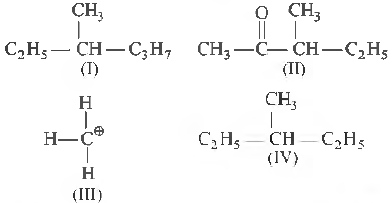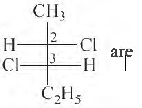Refer to CBSE Class 11 Chemistry Organic Chemistry Some Basic Principles and Techniques MCQs Set B provided below available for download in Pdf. The MCQ Questions for Class 11 Chemistry with answers are aligned as per the latest syllabus and exam pattern suggested by CBSE, NCERT and KVS. Chapter 8 Organic Chemistry Some Basic Principles and Techniques Class 11 MCQ are an important part of exams for Class 11 Chemistry and if practiced properly can help you to improve your understanding and get higher marks. Refer to more Chapter-wise MCQs for CBSE Class 11 Chemistry and also download more latest study material for all subjects
MCQ for Class 11 Chemistry Chapter 8 Organic Chemistry Some Basic Principles and Techniques
Class 11 Chemistry students should refer to the following multiple-choice questions with answers for Chapter 8 Organic Chemistry Some Basic Principles and Techniques in Class 11.
Chapter 8 Organic Chemistry Some Basic Principles and Techniques MCQ Questions Class 11 Chemistry with Answers
Question: The number of meso-forms in the following compound is
HOOC- CH(CH3 )· CH(OH)· CH(Cl)· CH(OH)CH(CH3 )· COOH
a) 3
b) 4
c) 8
d) 16
Answer: b
Question: Which of the following compounds is optically active ?
a) 1-butanol
b) Isopropyl alcohol
c) Acetaldehyde
d) 2-butanol
Answer: d
Question: Which of these contains the carbonyl group?
a) ketones
b) aldehydes
c) esters
d) all of these
Answer: d
Question: Butanone is a four-carbon compound with the functional group –
a) carboxylic acid
b) aldehyde.
c) ketone
d) alcohol.
Answer: c
Question: The number of primary, secondary and tertiary carbons in 3, 4-dimethylheptane are respectively
a) 4, 3 and 2
b) 2, 3 and 4
c) 4, 2 and 3
d) 3, 4 and 2
Answer: a
Question: The total number of isomers for C4H8 is
a) 5
b) 6
c) 7
d) 8
Answer: b
Question: Isomers of propionic acid are
a) HCOOC2H5 and CH3COOCH3
b) HCOOC2H5 and C3H7COOH
c) CH3COOCH3 and C3H7OH
d) C3H7OH and CH3COCH3
Answer: a
Question: In laboratory, first organic compound was synthesised by
a) Kekule
b) Hennel
c) Wohler
d) Liebig
Answer: c
Question: Which of the following scientist proposed that a ‘vital force’ was responsible for the formation of organic compounds ?
a) Berzilius
b) Wohler
c) Berthelot
d) Kolbe
Answer: a
Question: The percentage of s- character of the hybrid orbitals in ethane, ethene and ethyne are respectively.
a) 50, 75, 100
b) 10, 20, 40
c) 25, 33, 50
d) 25, 50, 75
Answer: c
Question: Tautomerism is exhibited by

Answer: a
Question: Which of the following carbocations is least stable?
a) tert-Alkyl
b) sec-Alkyl
c) pri-Alkyl
d) Methyl
Answer: d
Question: 2- Pentene contains
a) 15 σ- and one π- bond
b) 14 σ-and one π- bond
c) 15 σ- and two π- bonds
d) 14 σ- and two π- bonds
Answer: b
Question: CH3CH2OH and CH3OCH3 are the examples of
a) chain isomerism
b) functional isomerism
c) position isomerism
d) metamerism
Answer: b
Question: Which of the following compounds is isomeric with 2, 2, 4, 4- tetramethylhexane?
a) 3-ethyl -2, 2- dimethylpentane
b) 4-isopropylheptane
c) 4-ethyl-3-methyl-4-n propyloctane
d) 4, 4-diethyl-3-methylheptane
Answer: b
Question: Among the following four structures I to IV

it is true that
a) all fow- are chiral compounds
b) I and II are chiral compounds
c) only ill is a chiral compound
d) IT and IV are chiral compounds
Answer: b
Question: The hybridisation of carbon atom in C — C single bond of H2C = CH — CH = CH2 is
a) sp3 — sp
b) sp2 — sp
c) sp2 — sp2
b) sp3 — sp3
Answer: c
Question: In the hydrocarbon CH3 – CH = CH – CH2 – C ≡ CH
6 5 4 3 2 1
The state of hybrization of carbons 1, 3 and 5 are in the following sequence
a) sp2, sp, sp3
b) sp, sp3, sp2
c) sp, sp2, sp3
d) sp3, sp2, sp
Answer: b
Question: Which of the following is incorrectly matched –
a) vinegar →carboxylic acid
b) C2H6 →alkane
c) ethanol →alcohol
d) methanol →ketone
Answer: d
Question: The absolute configuration of the following

a) 2S, 3R
b) 2S, 3S
c) 2R, 3S
d) 2R, 3R
Answer: b
Question: The discovery that shook the belief in the vital force theory was
a) Stereoisomerism
b) Synthesis of indigo
c) Wholer’s synthesis of urea from ammonium cyanate
d) Fermentation of sugars
Answer: c
Question: The IUPAC name of CH3COCH (CH3)2 is -
a) isopropyl methyl ketone
b) 2-methyl-3-butanone
c) 4-methylisopropyl ketone
d) 3-methyl-2-butanone
Answer: d
Question: Who is known as the “Father of Chemistry”?
a) Faraday
b) Priestley
c) Rutherford
d) Lavoisier
Answer: d
Question: Which are isomers ?
a) ethyl alcohol and dimethyl ether
b) acetone and acetaldehyde
c) propionic acid and propanone
d) methyl alcohol and dimethyl ether
Answer: a
Question: The functional group present in CH3COOC2H5 is –
a) ketonic
b) aldehydic
c) ester
d) carboxylic
Answer: c
Question: Which of the following have incorrect molecular formula?
A. Icosane – C10H22
B. Triacontane – C30H62
C. Nonane – C9H20
D. Heptane – C7H14
a) (a) and (d)
b) Only (d)
c) (b) and (d)
d) Only (b)
Answer: a
Question: The compound which has one isopropyl group is
a) 2, 2, 3, 3 - Tetramethylpentane
b) 2, 2 - Dimethylpentane
c) 2, 2, 3- Trimethylpentane
d) 2- Methypentane
Answer: d
Question:

Compound can exhibit
a) geometrical isomerism
b) tautomerism
c) optical isomerism
d) geometrical and optical isomerism
Answer: c
Question: The successive members in a homologues series differ from each other by ________
a) – CH2CH2 – unit
b) – CH2 unit
c) – OCH3 unit
d) – CH3 unit
Answer: b
Question: An aromatic compound of formula C7H7Cl has in all ..... isomers :
a) 5
d) 2
c) 4
d) 3
Answer: c
Question: Geometrical isomerism is possible in
a) acetone oxime
b) isobutene
c) acetophenone oxime
d) benzophenone oxime
Answer: c
Question: Ethers are isomeric with
a) aldehydes
b) ketones
c) both aldehydes and ketones
d) alcohols
Answer: d
Question: Which of the following organic compound was synthesised by F. Wohler from an inorganic compound?
a) Methane
b) Urea
c) Acetic acid
d) Chloroform
Answer: b
Question: Which of the following will have a meso-isomer also?
a) 2-chlorobutane
b) 2, 3-dichlorobutane
c) 2, 3-dichloropentane
d) 2-hydroxypropanoic acid
Answer: b
Question: The name of the compound

is
a) (2Z, 4Z)-2, 4-hexadiene
b) (2Z, 4E)-2, 4-hexadiene
c) (2E, 4Z)-2, 4-hexadiene
d) (4E, 4Z)-2, 4-hexadiene
(e) (2E, 4E)-2, 4-hexadiene
Answer: a
Question: Geometrical isomerism is shown by
a) —C—C—
b) C=C
c) — C- C—
d) None of these
Answer: b
Question: What is the IUPAC name of t-butyl alcohol.
a) Butanol–2
b) 2–Methyl-propan–2-ol
c) Butanol–1
d) Propanol-2
Answer: b
Question: IUPAC name of (CH3)3 CCl is
a) 1-butyl chloride
b) 3-chloro butane
c) 2-chloro-2-methylpropane
d) 2-butyl chloride
Answer: c
Question: The compound, whose stereo-chemical fommla is written below, exhibits x geometrical isomers and y optical isomers The values of x and y are

a) 4 and 4
b) 2 and 2
c) 2 and 4
d) 4 and 2
Answer: b
Question: The shape of methyl carbanion is similar to that of –
a) BF3
b) NH3
c) methyl free radical
d) methyl carbocation
Answer: b
| CBSE Class 11 Chemistry Structure of Atom MCQs Set A |
| CBSE Class 11 Chemistry Structure of Atom MCQs Set B |
| CBSE Class 11 Chemistry Structure of Atom MCQs Set C |
| CBSE Class 11 Chemistry Classification of Elements and Periodicity in Properties MCQs Set A |
| CBSE Class 11 Chemistry Classification of Elements and Periodicity in Properties MCQs Set B |
| CBSE Class 11 Chemistry Periodic Classification of Elements MCQs |
| CBSE Class 11 Chemistry Redox Reactions MCQs Set A |
| CBSE Class 11 Chemistry Redox Reactions MCQs Set B |
| CBSE Class 11 Physics Kinetic Theory MCQs Set C |
MCQs for Chapter 8 Organic Chemistry Some Basic Principles and Techniques Chemistry Class 11
Expert teachers of studiestoday have referred to NCERT book for Class 11 Chemistry to develop the Chemistry Class 11 MCQs. If you download MCQs with answers for the above chapter you will get higher and better marks in Class 11 test and exams in the current year as you will be able to have stronger understanding of all concepts. Daily Multiple Choice Questions practice of Chemistry will help students to have stronger understanding of all concepts and also make them expert on all critical topics. After solving the questions given in the MCQs which have been developed as per latest books also refer to the NCERT solutions for Class 11 Chemistry. We have also provided lot of MCQ questions for Class 11 Chemistry so that you can solve questions relating to all topics given in each chapter. After solving these you should also refer to Class 11 Chemistry MCQ Test for the same chapter.
You can download the CBSE MCQs for Class 11 Chemistry Chapter 8 Organic Chemistry Some Basic Principles and Techniques for latest session from StudiesToday.com
Yes, the MCQs issued by CBSE for Class 11 Chemistry Chapter 8 Organic Chemistry Some Basic Principles and Techniques have been made available here for latest academic session
You can find CBSE Class 11 Chemistry Chapter 8 Organic Chemistry Some Basic Principles and Techniques MCQs on educational websites like studiestoday.com, online tutoring platforms, and in sample question papers provided on this website.
To prepare for Chapter 8 Organic Chemistry Some Basic Principles and Techniques MCQs, refer to the concepts links provided by our teachers and download sample papers for free.
Yes, there are many online resources that we have provided on studiestoday.com available such as practice worksheets, question papers, and online tests for learning MCQs for Class 11 Chemistry Chapter 8 Organic Chemistry Some Basic Principles and Techniques

